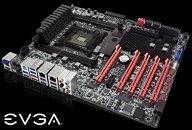Wednesday, October 26th 2011

EVGA X79 FTW Motherboard Pictured
EVGA released a teaser picture of its X79 FTW motherboard. This is EVGA's third LGA2011 motherboard, after the E-ATX Super Record 3 and XL-ATX X79 Classified. This board confines itself to the dimensions of a standard ATX form-factor motherboard (240 x 300 mm). It targets the gamer-overclocker market. The LGA2011 socket is powered by a 14-phase VRM, while the memory, 4-phase. EVGA completely did away with cylindrical conductive polymer capacitors, and used a 100% POSCAP capacitor design. Power is drawn in from a 24-pin ATX (angled) connector, 8-pin EPS, and a 4-pin Molex (for PCIe slot electrical stability). There are just four DDR3 DIMM slots, one per memory channel.
Expansion slots include four PCI-Express 3.0 x16 (two are x16 capable, all four are x8 capable), a PCI-Express 2.0 x16 (electrical x8), and one PCIe x1. NVIDIA 4-way SLI and AMD CrossFireX are supported. The only internal SATA ports on this board are the ones the X79 PCH gives out, two SATA 6 Gb/s and four SATA 3 Gb/s. There are two eSATA ports, driven by a third-party controller. There are as many as eight USB 3.0 ports on the rear-panel, and two via internal header. 8+2 channel HD audio, two GbE connections, a Bluetooth connection, and PCH-wired USB 2.0 ports (for keyboard/mouse) make for the rest of the standard connectors. There is an EVBot header on the rear-panel, that lets you connect to the EVBot monitoring/control module. The UEFI BIOS is stored in two separate EEPROMs, and a 2-way switch lets you manually switch between the two. Expect the X79 FTW to be a part of the company's first wave of LGA2011 motherboards.
Expansion slots include four PCI-Express 3.0 x16 (two are x16 capable, all four are x8 capable), a PCI-Express 2.0 x16 (electrical x8), and one PCIe x1. NVIDIA 4-way SLI and AMD CrossFireX are supported. The only internal SATA ports on this board are the ones the X79 PCH gives out, two SATA 6 Gb/s and four SATA 3 Gb/s. There are two eSATA ports, driven by a third-party controller. There are as many as eight USB 3.0 ports on the rear-panel, and two via internal header. 8+2 channel HD audio, two GbE connections, a Bluetooth connection, and PCH-wired USB 2.0 ports (for keyboard/mouse) make for the rest of the standard connectors. There is an EVBot header on the rear-panel, that lets you connect to the EVBot monitoring/control module. The UEFI BIOS is stored in two separate EEPROMs, and a 2-way switch lets you manually switch between the two. Expect the X79 FTW to be a part of the company's first wave of LGA2011 motherboards.

20 Comments on EVGA X79 FTW Motherboard Pictured
You know like use the 2 far most outward slots on both sides.
Now, if only I could get a sample for review....:banghead:
I do find the number of SATA ports to be lacking, also ram. I wonder if there are less ram slots to make bandwidth for other features, such as larger number of full 16x pci slots.
And yes, it IS starting to become a "standard" so to speak. I have like 20 boards here, and only three of them actually have all seven slots. Most are six.
This allows them to lessen wiring in the board for a slot that almost never gets used. At least they have dropped the second slot down, compared to other OEMs that drop the uppermost slot.
running eight HDD's plus two opticals, is going to be an issue for many PSUs. I do nto understand why users want so many ports...can you explain why 10 ports is not enough?
ram slots are enough for most users, fitting 4x2 GB for 8GB, or 4x4 GB, for 16GB. As nearly no user will make full use of the ram, I see no reason to have more except on workstation products. I'd rather have them save the plastic, and maybe it makes a differnce for ram clocking...I'll be finding out myself, for sure. ;)
You do not sound ignorant, Captain.Abrecan, but I do feel that some of your concerns/needs are unfounded, and question whether such requirements are even needed in the first place for youself, as I have no question about most users having such needs...
I think you'll find many boards built for high-end overclocking configured quite similarily.
Full use of the ram in my case depends on a lot. If I have entire assemblies open in solidworks, plus the drawing vault, lotus notes with the project database open plus the browser with java parts libraries and timesheet etc. I could use 16 easy. Usually 12, unless Maya is open too because I am porting stuff between the two.
But I am not arguing with you either, there is no one board to rule them all. Workstation boards exist for these purposes. I just don't like buying them, I like gaming motherboards for new socket support.
This board, however, like most EVGA products, is centered around overclocking ability. Overclocking and long-term reliability don't go together in the same sentence from my perspective, altthough I do personally understand how the extra performance can greatly reduce time to complete projects, and save on labour costs.
There will be products that will meet your needs...for sure...just not every one is going to have the features you need, and will be overclocking-centric.
I truly feel that users with your requirements are a small part of the market, and I do not think it's realistic for every board to cater to every user. If such was the case, there would be no point in me reviewing boards. ;)
GPU's, I haven't had a problem with though.
Also, The fact that they could have moved the ram slots farther away from the CPU on BOTH sides seems ridiculous that they didnt!!